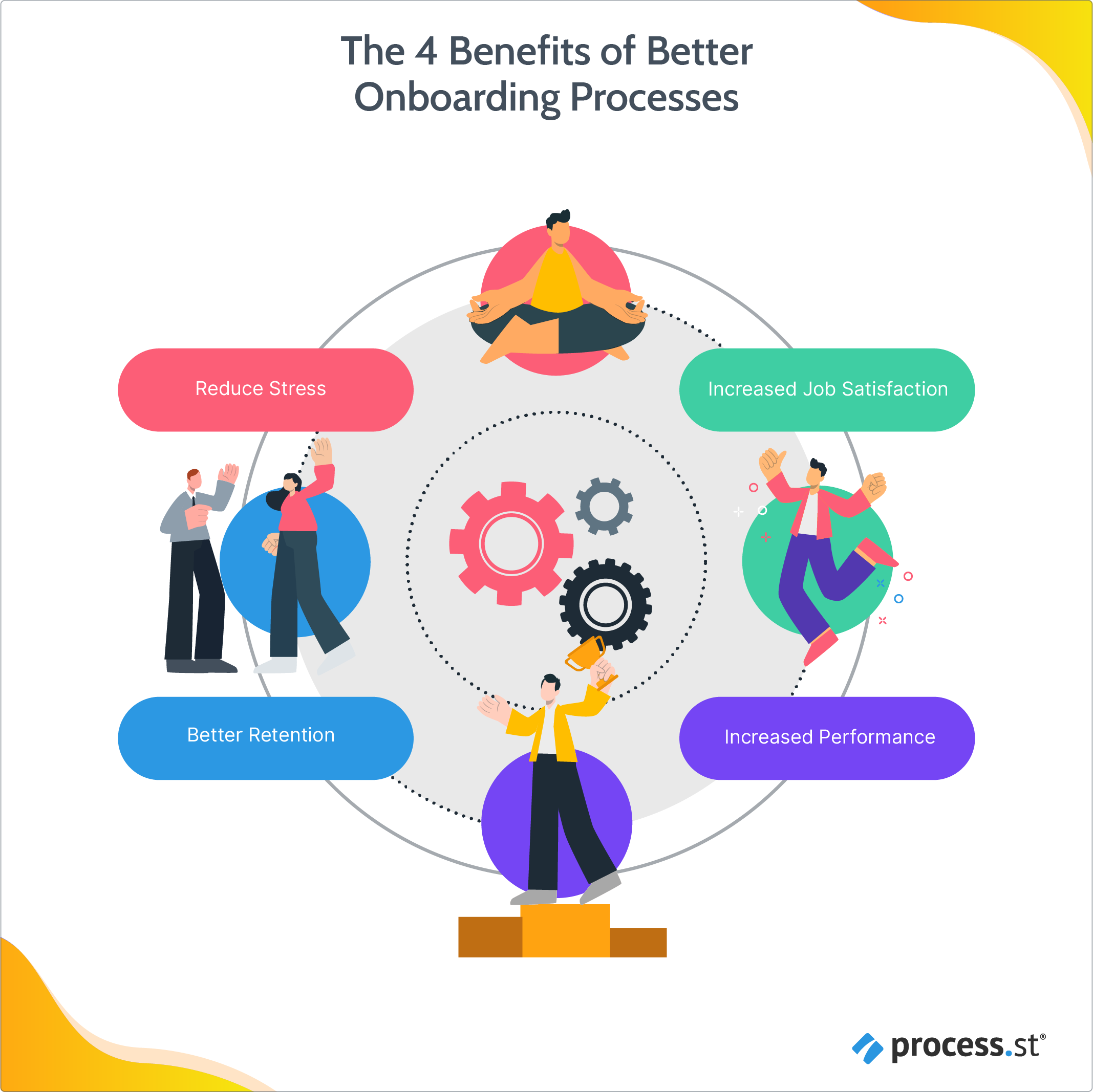We Need to Talk About Your Employee Onboarding Process (& How to Fix It)
Blog: The Process Street Blog
 Yeah, onboarding is important. You need to make a good first impression. You need to have a consistent process. You need to make sure your new hire has a good onboarding experience or they’ll probably quit before you have a chance to add them to the employee directory.
Yeah, onboarding is important. You need to make a good first impression. You need to have a consistent process. You need to make sure your new hire has a good onboarding experience or they’ll probably quit before you have a chance to add them to the employee directory.
Blah, blah, blah.
Blah.
The thing is with this whole onboarding process, though: It’s not what you do but how you do it.
You can have the most well-structured, well-developed, consistent, and thorough onboarding process but if you don’t deliver it well, that employee is going to walk away thinking, “Wow. WTF was that?”
I know, I know – “But, Leks,” you say, “I’ve read all your posts for Process Street and you keep saying we just need to build a strong process.”
It’s true. I love a good process and I have talked about it a lot. Sometimes you have to say things more than once for people to get it.
So far I’ve given you the technique of the employee onboarding process; let me show you the art.
- You’re not a cult: The 5Cs of employee indoctrination
- So don’t act like one: Ethical employee onboarding 101
- The employee onboarding practice, reborn
- Go do good things & don’t mess it up
You’re not a cult: 5Cs & employee indoctrination
I read a lot. It comes with the territory, right? You gotta keep up with all the new ideas, what people are talking about, all the unique ways of saying the same thing in a way that no one actually notices.
In planning this post, though, I said something to myself that no one has said since my university days. It’s a phrase my old mentor used to pull out every time I tried to half-ass my way through some French philosopher or another: You’re better than this. Do it right.
So I dug deeper and came across the 5Cs of the employee onboarding process which, inexplicably and much like my Deleuze oversight while specializing in monster studies, I had not yet encountered in all my human resources reading.
I was horrified. I couldn’t believe that HR and people teams still believed in the 21st century that this was an effective way to onboard their employees. Seriously, it read like total indoctrination rather than an onboarding process. All it needed was some poor junior employee forced to watch hours of company propaganda in a scene straight from A Clockwork Orange.
Wait a minute… 
I checked the dates on the articles; they were somewhat reassuringly a decade or so in the past but there were still a few outliers who’d dragged the concept into the last few years. I figured – this strategy has had to have been debunked by now and headed straight for Google scholar (my home away from home) convinced my fellow academics would put my concerns to rest.
They did not.
The 5Cs of employee onboarding processes: A breakdown
Full disclosure: I have been re-reading 1984 so my mind may already be primed to expect creepy overlord vibes, but I maintain that the 5Cs are genuinely unsettling.
What are these 5 words that put fear in the hearts of well-meaning content writers everywhere? Have a look: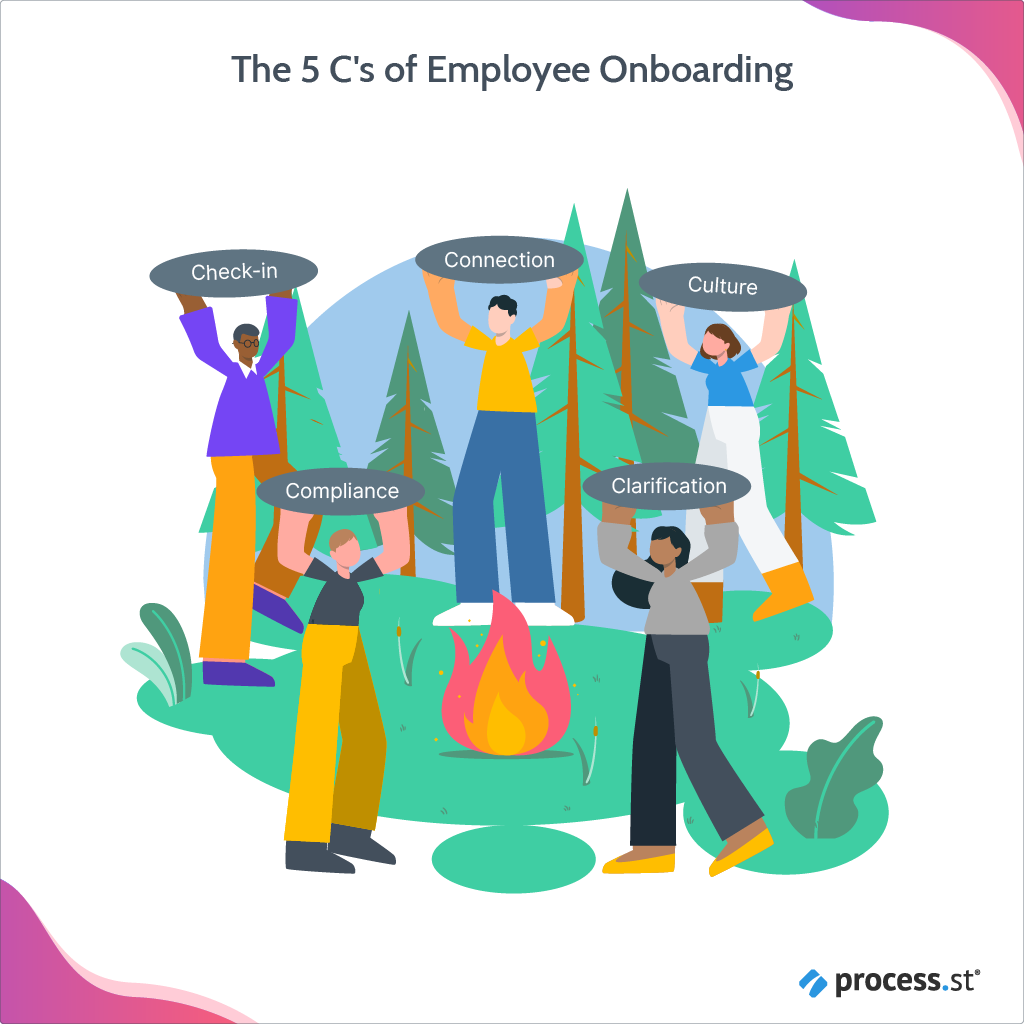 Compliance. Clarification. Culture. Connection. Check-in. Let’s discuss.
Compliance. Clarification. Culture. Connection. Check-in. Let’s discuss.
I admit to a bit of melodrama here but you know artists – just full of all those feelings. The words themselves (minus compliance) aren’t particularly frightening or disturbing. In fact, like you, I would look at most of them and agree that they should definitely be part of a positive onboarding experience.
It is true: clarifying responsibilities and expectations, introducing them to company culture, facilitating connections and relationships with colleagues, and frequent check-ins are all vital and essential to successful employee onboarding.
Later on, I’ll explain how you can use the 5Cs and not be a dick about it, but for now, I’m just going to do what I do best: Pick apart a well-established theory by industry experts because, in all my veritable wisdom, I disagree with it.
The main objection I have to the 5Cs is that – at least on the new hire’s part – it’s an incredibly passive way to onboard an employee. Replace the Kubrick aesthetic with someone sitting in a conference room watching 30-year-old videos and it really doesn’t seem much different, does it?
Onboarding process phase 1: Compliance
Compliance sets the tone for the rest of the employee’s experience at your company. This is getting all the paperwork filled out, contracts signed, policies and procedures reviewed – the boring stuff, basically.
All good. It’s also about setting expectations and explaining to the employee how they should act within your organization. To quote Toby Graham from KPA:
- Employees are expected to do the right thing – because it’s the right thing.
- It’s easier to do the right thing than the wrong thing.
- Employees who do the wrong thing will be caught and disciplined or terminated.
All of these things are true – though I would argue that doing the wrong thing is often incredibly easy while the right thing usually requires some forethought – but the way it’s presented establishes an adversarial relationship.
With this framing, the new hire is not an addition to the company that will be working with you to achieve company goals. They are clearly and unequivocally working for you and that imbalance of power is an important part of your company culture.
Onboarding process phase 2: Clarification
In this stage, you tell the employee what they’ll be doing – projects they’ll be working on, teams and colleagues they’ll be working with, how their role fits into the company, and what their responsibilities to the company are.
Again, all very important things for your employees to know and understand, but the purpose of this stage is more telling than teaching.
Your new hire has no active role here.
Onboarding process phase 3: Culture
Company culture is a huge part of employee engagement and job satisfaction. Good work-friends can make even the most frustrating project enjoyable and stimulating. On the other hand, you could be performing your absolutely favorite task with someone you don’t get along with and be miserable the whole time.
According to the 5Cs, new hires need to be instructed on what the company culture is, and how they should act to fit into that existing culture. Instead of welcoming and introducing your employee to the culture (or making sure they’ll be a good fit way back during the hiring process), you push them into conforming to how things already are.
I won’t argue that culture fit isn’t vital for employee success, but the 5Cs advocate organizational-identity socialization as opposed to a personal-identity one, which only serves to show employees that they can’t be their true selves in the workplace.
I’ll talk more about organizational-identity and personal-identity in the next section, but suffice it to say that Big Brother is all about organizational-identity. Do you want to be like Big Brother?
Onboarding process phase 4: Connection
I don’t have a problem with this C at all. Basically, introduce your new hire to as many people within the company as possible – especially those they’ll be working with regularly. Give them a mentor or buddy for some informal, no-pressure support.
The main thing with this one is that, as the manager, you have to be proactive. Granted, you can’t force someone to be social, but running down a list of names, tossing your employee into the team, and walking off will not good relationships build.
You know those documentaries about zoos and nature reserves where they have to introduce someone new to the established population?
They go through a whole series of steps to make sure both the new kid and the existing members are comfortable before leaving them on their own. Introductions, short visits, supervised interactions all ensure that a new individual finds a place and is welcome on the team.
Your new hire and their new team members are no different. There will be a transition period where everyone is assessing each other, figuring out how they fit, and how they’ll work together. As their manager, your role is to be there as a support if things go wrong or conflicts happen. Ease the transition.
Onboarding process phase 5: Check-in
Likewise, you can’t really say check-ins aren’t good. However, given that a majority of people writing about this topic only refer to 4Cs – and those that include check-ins refer to it as a “bonus C” – it is apparently not an obvious onboarding task.
You need to check in with your new hire. Read the above section about not just tossing them in and walking off.
Say your formalized, introductory employee onboarding process lasts for 3 months. By the end of that 3 months of closely-supervised and closely-structured interactions, your new hire is probably feeling pretty confident in their abilities.
Then you release them into the wild and the app everyone uses to share documents encounters a glitch that no one in the company has ever seen before or their very first customer rips their head off for not knowing a detail that wasn’t part of the initial onboarding. (Customers have bad days, too.)
Unexpected things happen so you need to keep in touch and address any questions, obstacles, bottlenecks, or ideas your employees may have.
Here at Process Street, I talk to my direct supervisor 1:1 at least once a week, more if something comes up that needs to be discussed or we don’t cover everything in the scheduled meeting.
You know who directs those 1:1s? Me. It’s not just what my supervisor wants to talk about with me; it’s about what I want to discuss with him. Well, it’s not entirely just what he wants to talk about. 
You need to check in with your new hire at least on a 30-60-90 schedule, but more frequent talks are never a bad thing.
So don’t act like one: Ethical employee onboarding 101
Hold onto your hats, kiddos: I am about to throw a bunch of terminology in your direction. Some of it you’ve heard me mention. Some of it you’ve encountered from other sources. Some you may have never heard of at all.
That’s okay. But it’s all important.
This section will cover 3 main points (in this order):
- Socialization methods
- Onboarding ethics
- Psychological safety
Don’t worry – I’ve read all the papers and, unlike the people who wrote them, I know how to speak human. You’re in safe hands, I promise.
Employee onboarding process & socialization methods
“Socialization method” is really just another way to say “introduce to your company.” Whether you realize it or not, you currently use some sort of socialization method in your employee onboarding process. Which one, exactly, might vary.
There are two primary approaches that companies tend to use in their onboarding process:
- Organizational-identity socialization: From day one, new hires are pressured to take on the company’s values and perspectives.
- Personal-identity socialization: New hires are given the opportunity to express their unique strengths and abilities.
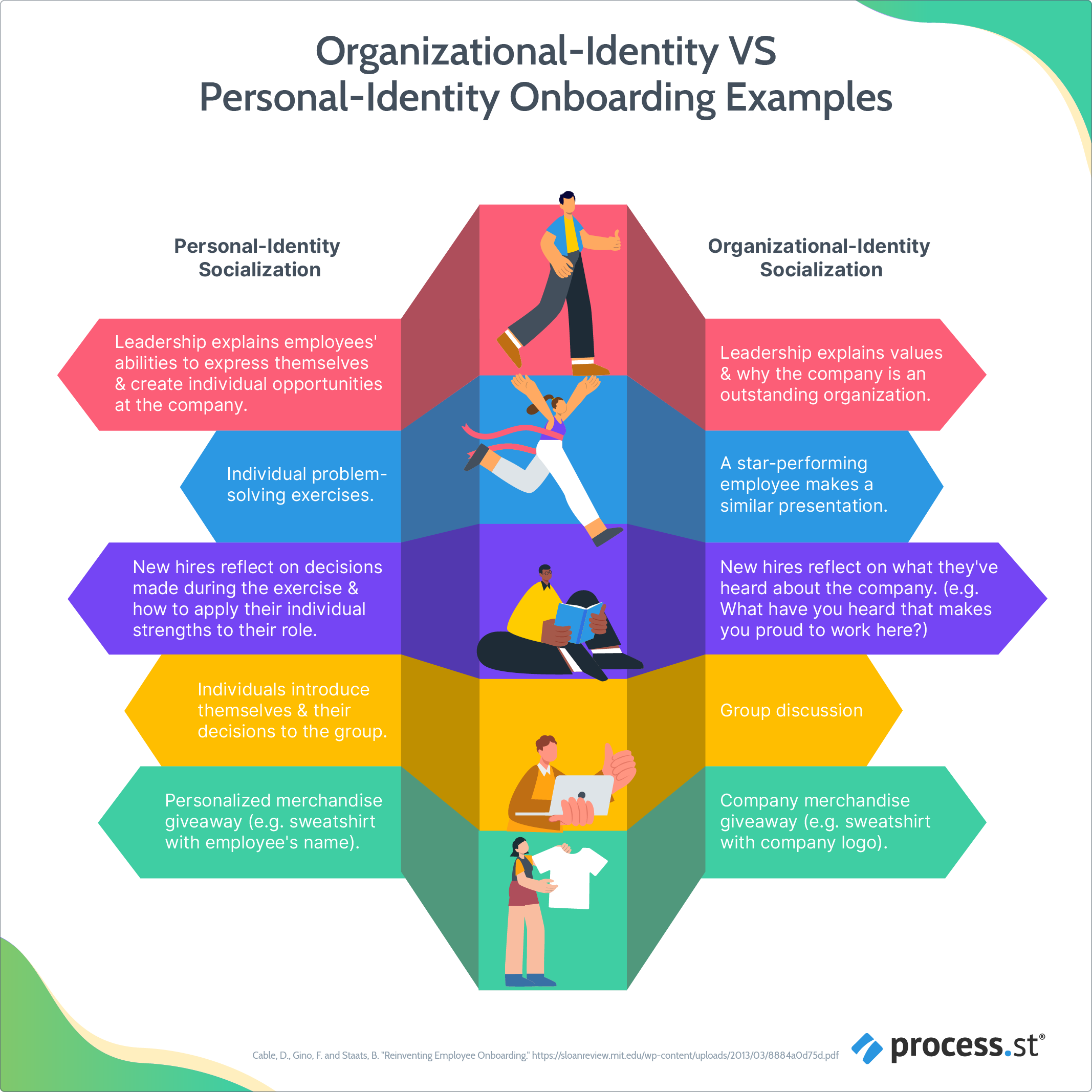 Traditionally, companies have preferred the organizational-identity approach. This is the kind where you sit the employee down and have them read through all the company material so they thoroughly understand, model, and embrace the company’s values, perspectives, and cultures.
Traditionally, companies have preferred the organizational-identity approach. This is the kind where you sit the employee down and have them read through all the company material so they thoroughly understand, model, and embrace the company’s values, perspectives, and cultures.
In this method, essentially, the employee’s personal identity is suppressed beneath the company’s identity. It does work. It wouldn’t be so popular if it didn’t. However, there’s a risk to it.
Your employees need to believe in your values. They need to share them, and you can’t make that happen. You can regulate external behavior, implement regulations and guidelines, enforce consequences for noncompliance – but none of that is going to change how your employee thinks and feels.
To be honest, doing any of that will probably only push them further away from the values you want them to embrace – or convince them that you don’t believe in your own values at all.
This distrust and cynicism lead to disengaged employees, high attrition rates, and low morale. You’re also preventing your employees from actually reaching their full potential. This will become clearer in the section on psychological safety, but if your employees aren’t comfortable sharing their ideas, you’re going to miss out on a lot of opportunities.
And, more than likely, your competitors won’t be as shortsighted.
Personal-identity socialization offers more flexibility. And, yes, this is the approach we use at Process Street so, of course, I’m going to think it’s better. But seriously – it really is.
Every place I’ve ever worked before Process Street has relied on organizational-identity socialization. Was it effective?
Nope. Not at all.
There was a huge chasm between leadership and employees, with employees acting one way around leadership while another way when on their own. Shortcuts were made, corners were cut, and no one was really invested in the company at all beyond the less-than-satisfying paycheck that came with it.
My first day of onboarding at Process Street, my training buddy said:
Right. We have an onboarding process, and you’re going to go through it. But we’re also going to improve it as we go based on your experience. We’re going to make sure that every step that needs to be there is there, and every step that doesn’t is taken out.
I just said okay and didn’t really think about it, but that’s exactly what we did. Every task I completed was followed up by an evaluation:
- Was this article helpful?
- Is this video outdated?
- Are these instructions clear?
- How can we improve this process?
So, from day one, the experience, knowledge, skills, and abilities that I’d been hired for were immediately put to use and immediately given value. It didn’t matter that everyone else on the team had been there longer; my perspective had just as much weight and importance as theirs.
Since then, I’ve participated in all sorts of projects, ideas, events, and anything else going on because Process Street maintains a culture where no one sits in a box.
If you have an idea you think is really great, you run with it. See if it works and present it to the team – even if it doesn’t work because then the team can help you fix it.
Another department is working on a project you think is interesting? Jump in and offer your skills.
We’re actively encouraged to try new things, experiment with new ideas, and create new processes. Hand to heart, every single one of us completely buys in and practices the company values – and not because we’ve been forced into it.
That’s what personal-identity socialization looks like.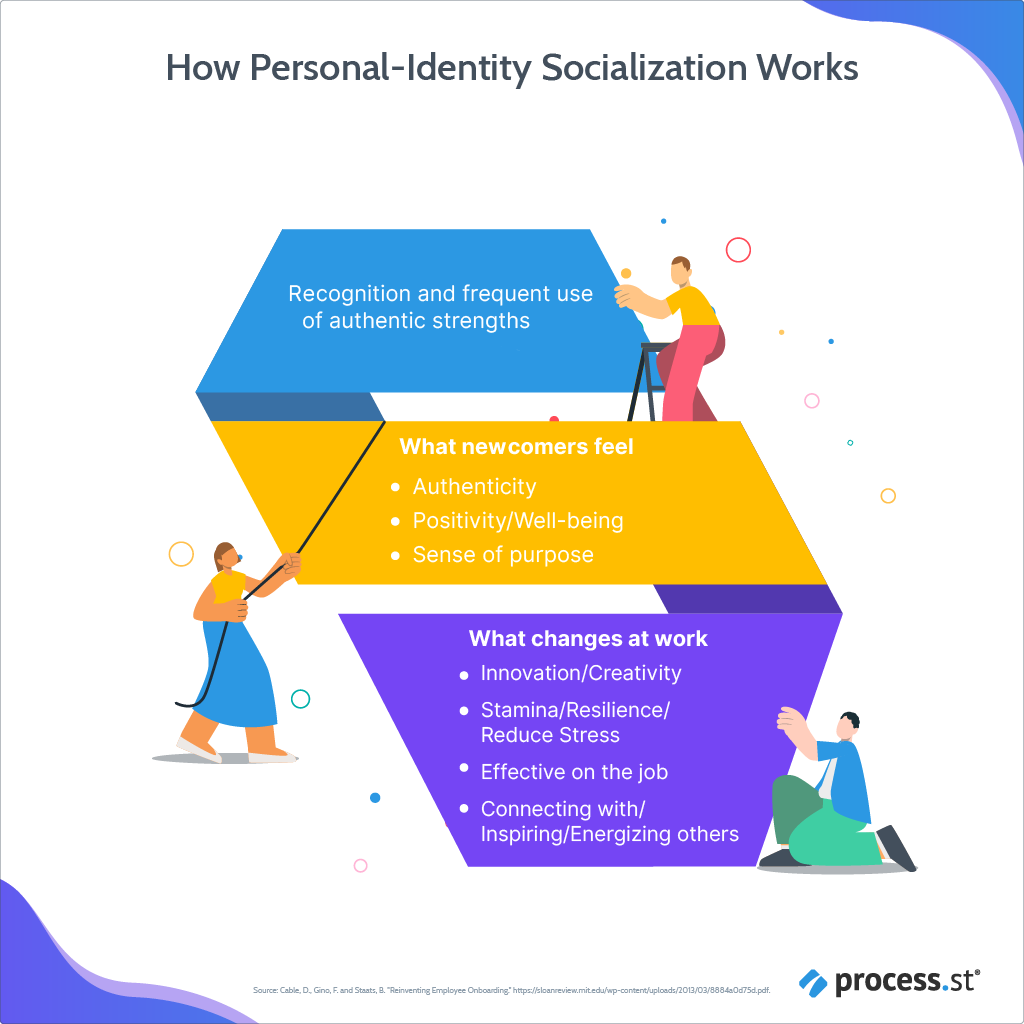
Employee onboarding process & ethical obligations
No, I don’t mean legal ethics or philosophical ethics. Here I’m talking about the psychological contracts made between you and your employee during the onboarding process.
And no, those aren’t the million-and-one documents you both have to sign before they get access to their company IT account.
A psychological contract is an unwritten agreement between two (or more) people. In simple terms, this is the agreement that the employee will do things for the company and, in return, the company will provide support in various ways (financial, benefits, development, etc.).
You and your employee are never going to sit down and hash out the details of your psychological contract – at least consciously. In fact, if you told an employee that you were going to do that, they’d probably wonder what you were even talking about.
From the new hire’s first day, there are expectations from every direction. The employee has expectations about the onboarding process and their work experience. You have expectations of their performance and ability to integrate. Their coworkers have expectations about that employee’s behavior and personality.
Anxiety is a large part of these expectations, as well.
As you’re onboarding your employees, think about the unspoken promises you’re making to each individual:
- How have you described future performance evaluations?
- What have you said about their new team or their new responsibilities?
- What milestones have you laid out for them for the next six months, the next year, the next two years?
- Are those milestones actually achievable?
- What promises were made during the recruitment process and are you fulfilling those promises now?
I will tell you straight up: It is not a good look to hire someone with the promise of one view of the role and pull a bait-and-switch once they’ve signed the contract. That is definitely the fastest way to ensure your new hire never trusts anything you say again.
These promises are the psychological contract between the two of you. Are you fulfilling your side of the bargain? Is the employee fulfilling their side? Like in any other aspect of business, a broken contract – even an unwritten one – has far-reaching ramifications.
And here is the ethics side: Because it’s unwritten, unconscious, and created between just you and the employee, if that contract is broken, there’s no one to hold you accountable.
Once that employment contract is signed, you could very well not follow through on promised benefits, not provide adequate training or development, or any number of things. The employee may call you out on it, but in the end, the only thing keeping you honest is your ethical obligation and consideration of the person you made those promises to.
And again, your employee doesn’t need you. Top talent is in short supply and high demand.
Employee onboarding process & psychological safety
Remember when I said it’s not the what it’s the how? This is what I mean.
Psychological safety as a concept has been passed around by various psychologists, organizational researchers, and assorted managers since the 1960s. More recently, however, it’s been the focus of Dr. Amy Edmondson, a leadership and management professor at Harvard Business School.
In her paper, “Psychological Safety and Learning Behavior in Work Teams,” Dr. Edmondson defines psychological safety as “a shared belief that the team is safe for interpersonal risk-taking.”
Similar to the psychological contracts you have with your employees, psychological safety isn’t something anyone notices until it isn’t there. More often than not, individuals wouldn’t be aware psychological safety is the foundation for whether or not they feel comfortable at work. But we’ve all been in workplaces where we just knew sharing our ideas wouldn’t be welcome.
That’s an example of psychological danger, and people in those situations basically clam up. They aren’t creative, collaborative, or – and this does matter – happy. Instead, you have fear: of failure, judgment, blame, exclusion, and so on.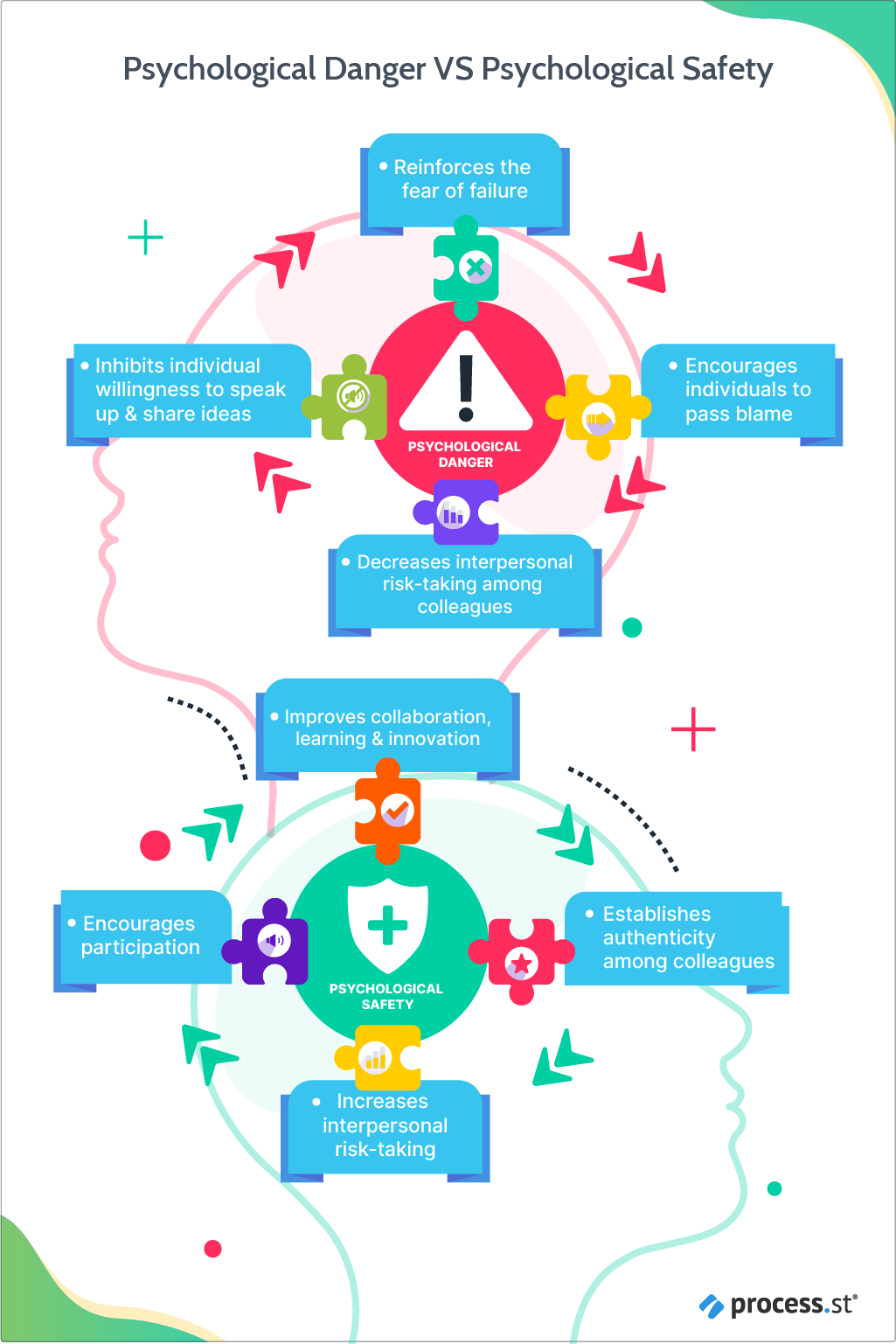 Now, to clarify: Psychological safety isn’t the same thing as trust. They’re related, of course; you’re likely to trust the individual members of a team you feel safe with. The important distinction between the two is who they describe.
Now, to clarify: Psychological safety isn’t the same thing as trust. They’re related, of course; you’re likely to trust the individual members of a team you feel safe with. The important distinction between the two is who they describe.
Trust is on an individual level. Do you trust that Harriet hasn’t swiped your sandwich laced with scorpion peppers? (Serves you right, Harriet.)
Psychological safety, on the other hand, is about the group. Do you feel confident that your team members will consider your idea seriously even if it turns out that it’s not a good idea? More to the point: Do you feel confident that your team will still support you even if you come up with a bad idea?
Just like you can’t make someone be social, or make them buy in to your values, you can’t make someone feel safe. You have to cultivate that environment and maintain it continuously.
With a new hire, you get one chance at this. Either you build a relationship of trust and mutual respect – and consequently, establish a sense of safety – by directly involving your new hires in their onboarding process.
Or you don’t.
The employee onboarding process, reborn
One of our key values at Process Street is to overcommunicate everything, twice.
See how clever that is?
It’s probably one of my favorites, though. Surprise, surprise, the writer is all for communication, right?
The thing is, when it comes right down to it, most problems are the result of insufficient information. That may be too little information, not the right information, or outright misinformation. The point is: Communication is key to success.
There’s nothing inherently wrong with the 5Cs of onboarding. In fact, depending on who’s writing about them, they make a lot of sense. Whether they facilitate a positive or negative experience depends on the delivery – on your ability to communicate with your new hire and provide space for them to communicate in return.
As someone whose job is to write about processes for a company that literally has “process” in the name, I’m going to go out on a limb here: For your employee onboarding process to actually work, you have to stop thinking about it as an employee onboarding process.
Or – and this is probably more accurate – redefine what you think a process should look like. A standardized process doesn’t have to be cold, mechanical, and detached. In fact, when it comes to something like employee onboarding, it should be the exact opposite.
A standardized onboarding template doesn’t eliminate the need or the possibility of adding a human touch. A template is just that: a template. It gives you a framework to work from so you can be sure all the fine print is taken care of while focusing on providing that human touch to the onboarding experience.
If you look at a few of our pre-made employee onboarding templates, you’ll see there’s a lot of room for personalization in them. You can edit and adapt these workflows into a bespoke process for your organization, or use them as-is as a guide to keep you on track.
I mean, come on. I’ve done training without a guide before. I was so worried about leaving something out the entire time that – inevitably – I ended up leaving things out.
Using a standardized process gives you the confidence and consistency to connect with your new hire and provide them with a positive experience.
 Click here for some of our pre-made employee onboarding processes!
Click here for some of our pre-made employee onboarding processes!
Adapt this template to most new hire situations with features like:
- Conditional logic
- Automations
- Approvals
Add this workflow to your free Process Street account!
This checklist will make sure nothing gets left out due to features like:
- Due dates
- Variables
- Subtasks
Add this workflow to your free Process Street account!
This template is perfect for remote employees because of features like:
- File upload widget
- Email widget
- Calendar widget
Go do good things & don’t mess it up
When onboarding a new employee, you need to remember why you hired them in the first place.
You specifically chose that individual over all the other applicants because of their skills, abilities, and experiences. You felt that they had something unique and innovative to bring to your organization and would be a definite asset in achieving future goals.
Your employee onboarding process needs to reflect that. Onboarding shouldn’t be simply you telling your employees how they’ll fit into the company; you need to work with them so that both company and employee fit together.
Every new person introduced will change the dynamics of their team, their department – even the whole organization. If your company isn’t flexible enough to make space for these individuals – and your onboarding process doesn’t facilitate that – your new hires are destined to end up part of that 28% who leave within 90 days.
How human is your employee onboarding process? What do you think of the 5Cs? Let’s talk in the comments!
The post Blog first appeared on Process Street | Checklist, Workflow and SOP Software.
Leave a Comment
You must be logged in to post a comment.


